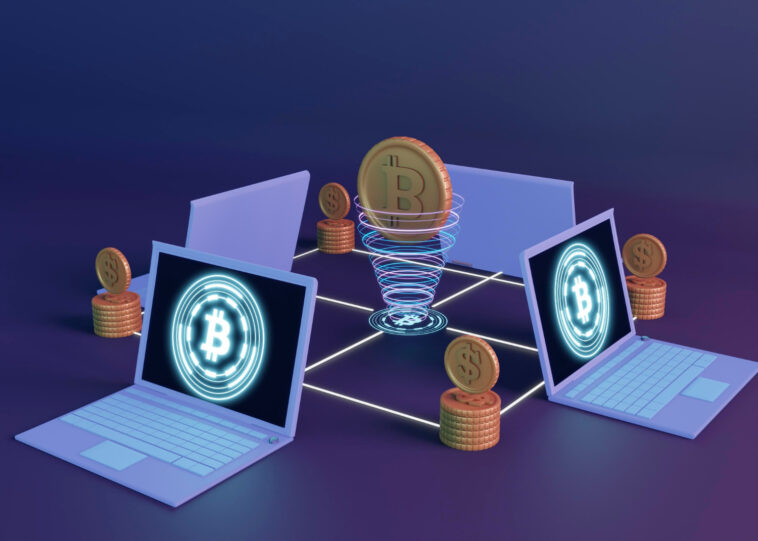Cryptocurrency mining involves verifying transactions and minting new coins as part of a decentralized cryptocurrency’s proof-of-work system, which enables it to function without central authority oversight.
Miners compete against each other to locate cryptographic hashes and add them to the blockchain, with winners typically receiving rewards such as cryptocurrency they mined as well as transaction fees for winning.
What Is Crypto Mining?
Crypto mining, also known as blockchain mining, involves verifying transactions on a blockchain using computer equipment, with the purpose of receiving cryptocurrency rewards in exchange. Miners use specialized hardware and software to carry out complex mathematical and cryptographic operations on the blockchain in order to validate new blocks of transactions – competing among themselves to find solutions while being rewarded for their work with digital coins such as Bitcoin in return.
Cryptocurrencies are decentralized digital currencies operating outside of government control, making them less regulated than regulated financial instruments such as fiat currency. Because cryptocurrencies operate outside this regulatory sphere, only very few governments have accepted or even acknowledged them; many still regard them with suspicion; thus making their future uncertain and highly speculative. Mining provides an important mechanism for validating transactions while upholding blockchain integrity.
Crypto mining requires significant energy. Crypto mining software must solve complex equations to add blocks to a blockchain, with more miners on a network increasing both difficulty and computing requirements to complete its task. Therefore, selecting suitable equipment that best meets both your needs and budget requirements is key for successful mining.
Crypto mining equipment consumes significant energy, contributing to climate change by emitting excess heat. To lessen their impact, miners tend to locate their equipment in countries with cheaper electricity rates – though such consumption has prompted some cryptocurrency communities to switch from PoW frameworks to more sustainable Proof-of-Stake systems.
Mining Bitcoin and other coins carries high costs and offers limited rewards; furthermore, cryptocurrency prices are highly unpredictable; even if successful at mining them, their price could fluctuate drastically and lead to major financial losses if their price suddenly decreases significantly. If engaging in crypto mining is something you are considering doing, be aware of all financial risks involved before embarking on such an endeavour and seek advice from qualified financial professionals before embarking on such venture.
How Does Crypto Mining Work?
Crypto mining is an activity that rewards participants with new coins for validating transactions on a blockchain network, like Bitcoin’s proof-of-work network. Other cryptocurrencies may utilize different validation techniques; mining is a complex mathematical problem requiring significant computing power and computing memory. Miners compete against one another to pinpoint a cryptographic hash (a truncated digital signature of transactions), with the first miner solving it winning an incentive prize consisting of newly issued coins.
Mining is an integral component of cryptocurrency’s ecosystem as it ensures no double spending occurs. Distributed ledgers like Bitcoin only permit verified transactions to be added; to keep its security intact, a protocol known as proof-of-work requires miners to validate transactions before adding them to the blockchain; these miners are financially motivated to do this because transaction fees associated with adding blocks of transactions can provide rewards from this action.
Cryptocurrencies are highly unpredictable investments, leaving even successful miners susceptible to financial ruin if the value of one coin suddenly plummets in price. Furthermore, mining equipment is expensive and consumes enormous amounts of electricity – creating environmental concerns as estimates indicate that one Bitcoin mining rig consumes equivalent electricity consumption as an entire nation like Finland in an entire year!
At its height in 2016 and 2017, Ethereum’s popularity led to a crypto mining gold rush, driving up GPU demand. People established large-scale mining farms using multiple GPUs to mine cryptocurrency. Mining pools helped these operations maximize profits and efficiency; miners also sought ways to minimize costs by choosing locations with lower electricity rates or access to high-speed Internet connectivity.
Mining cryptocurrency depends on several variables, including its price, computing power requirements and hardware costs. Miners must also factor in electricity and cooling costs as well as operating expenses when considering whether crypto mining will be profitable for them. Legal considerations regarding crypto mining vary by jurisdiction but generally treat it as an income generating activity and may subject earnings to income taxes. To gain more knowledge of cryptocurrency and legal matters related to it please visit Freeman Law’s Blockchain & Cryptocurrency Resource Page
What Are the Risks of Crypto Mining?
Cryptocurrency mining is an energy-consuming activity that consumes large amounts of electricity and requires keen competitive spirit in order to succeed. Financial risk may exist for individuals without access to low-cost energy supplies; profits may accrue to miners only if their cryptocurrency of choice increases in value over time, otherwise their investments may result in losses.
Crypto mining consumes such an immense amount of electricity that its energy use can increase electricity rates for consumers in a local power grid, increase credit risks for utilities, and cause service interruptions. Mining operations tend to peak during hot weather periods which is problematic for people using air conditioning or other electric appliances.
Mining requires powerful computers designed specifically for this task, which are both costly to purchase and operate. As such, many cryptominers pool together their processing power in mining pools in order to lower equipment and electricity costs and obtain greater rewards – larger pools typically produce more blocks and receive larger rewards than their smaller counterparts.
As cryptocurrency mining has expanded, so too have concerns over its effects on energy consumption and climate change. Given how proof-of-work cryptocurrency mining often prioritizes short-term needs for cheap electricity over longer-term investments in renewables, some state, local, and federal officials have taken measures to restrict its growth.
Though governments around the world have generally accepted Bitcoin and other digital currencies, they still keep an eye on their potential to raise financial system risks through cryptomining. For instance, in the US federal government has recently instituted requirements that crypto miners report transactions before potentially adding tax reporting requirements in 2023.
If you want to explore cryptocurrency mining, it is essential that you fully comprehend its risks. Do not use university resources for cryptocurrency mining activities as this puts university systems and personal devices at risk, in violation of University policy as well as potentially leading to unapproved use of your personal accounts, settings and data. For more information see U-M IT security best practices.
What Are the Rewards of Crypto Mining?
Mining cryptocurrency offers potentially substantial rewards. Miners are incentivised to secure the network by earning rewards of newly minted coins and transaction fees; powerful computers used by mining operations solve complex cryptographic hash puzzles to verify transactions on the blockchain ledger, providing decentralized, global record keeping.
Mining profitability depends on a range of factors; one key aspect being electricity cost. Therefore, large-scale mining operations often locate near energy sources like dams, oil/gas wells, solar farms or geothermal resources for maximum profitability. Furthermore, high powered devices like ASICs consume massive amounts of power while producing excessive heat that could potentially damage or cause fire without adequate ventilation systems in place.
Mining requires an upfront investment in hardware; Bitcoin mining rigs capable of competing with institutional miners may cost as much as $10,000 and their difficulty can change with Bitcoin’s value, thus impacting returns and potential returns.
As an alternative, some miners join pools to divide up any rewards when they successfully mine a block, helping to lower hardware costs while still reaping some reward from successful mining. Furthermore, you’ll need a wallet in which to store your cryptocurrency, with options from Coinbase, Trezor, and Exodus available as storage solutions.
No matter what the potential rewards may be, before investing in crypto mining operations it is always advisable to conduct extensive research. Consider all costs of ownership such as electricity and cooling expenses along with Bitcoin price and mining difficulty as indicators of whether the venture is worthwhile. In addition, consult local laws for guidance as mining may or may not be legal in your region.



